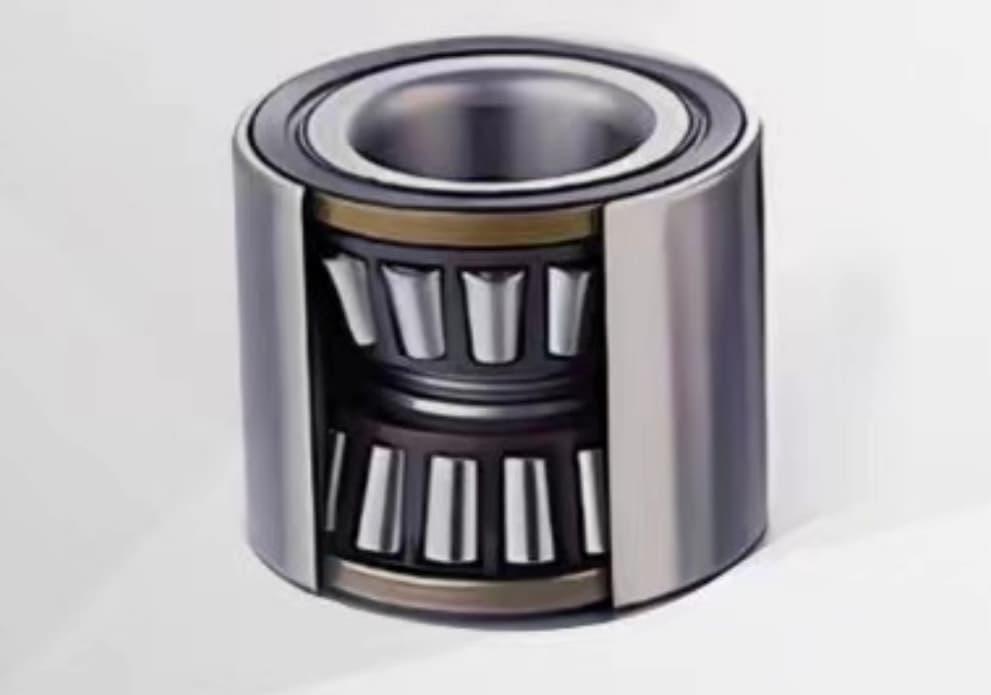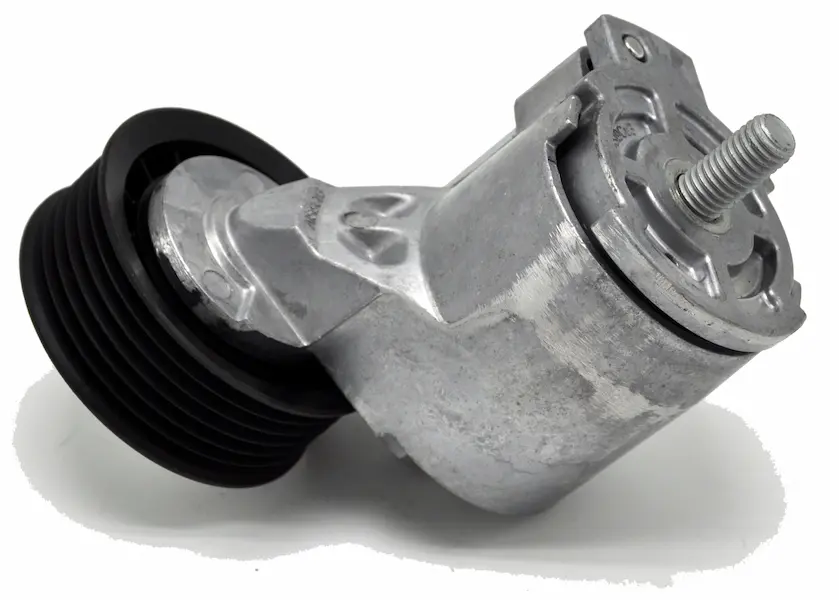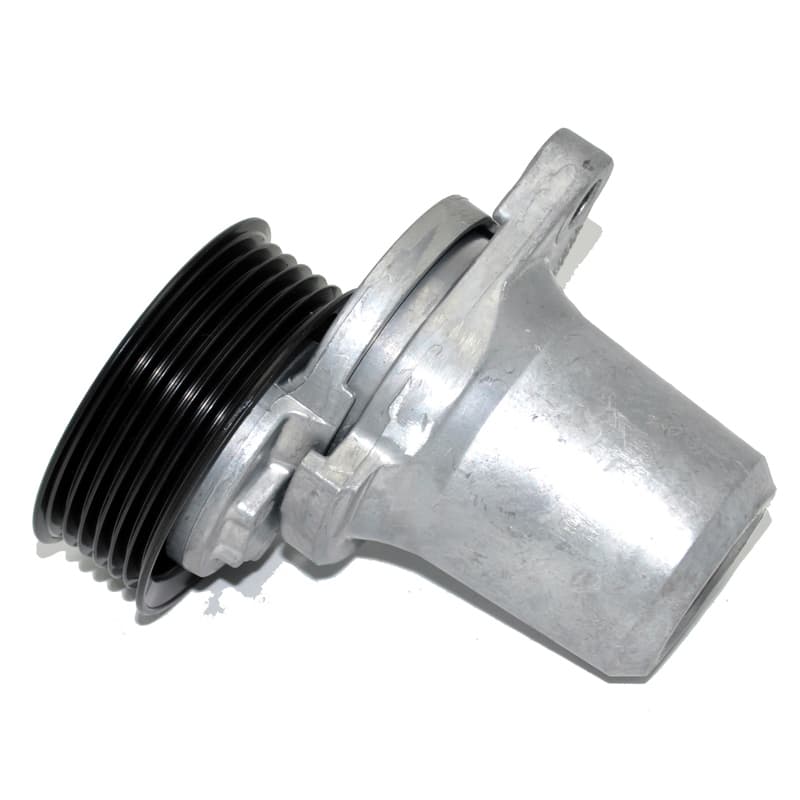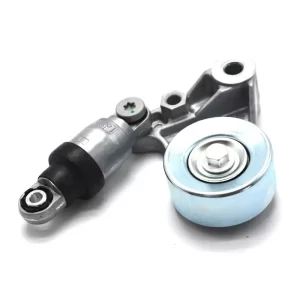In der Welt der Automobil- und Industriemaschinen sind die Effizienz und Zuverlässigkeit von riemengetriebenen Systemen entscheidend für die Leistung und Langlebigkeit der Anlagen. Eine oft übersehene Komponente, die in diesen Systemen eine entscheidende Rolle spielt, ist der Umlenkrolle Riemenspanner. Trotz seiner geringen Größe und scheinbar einfachen Funktion ist der Umlenkrollen-Riemenspanner von entscheidender Bedeutung, um sicherzustellen, dass die Riemen ordnungsgemäß gespannt, ausgerichtet und frei von Schlupf sind. Dieser Artikel befasst sich mit der Rolle von Umlenkrollen-Riemenspannern bei der Verhinderung von Riemenschlupf und untersucht ihre Konstruktion, Funktionsweise und die Vorteile, die sie bei der Aufrechterhaltung des reibungslosen Betriebs von mechanischen Systemen bieten.
Verständnis von bandgesteuerten Systemen
Bevor wir uns mit der spezifischen Rolle von Umlenkrollen-Riemenspannern befassen, ist es wichtig, die Grundlagen von riemengetriebenen Systemen zu verstehen. Sowohl in Kraftfahrzeugmotoren als auch in Industriemaschinen werden riemengetriebene Systeme üblicherweise zur Kraftübertragung von einem Bauteil auf ein anderes verwendet. In einem Verbrennungsmotor beispielsweise treibt ein Serpentinenriemen mehrere Zubehörteile wie die Lichtmaschine, die Servolenkungspumpe, die Wasserpumpe und den Klimakompressor an.
Der Riemen wickelt sich um die Riemenscheiben, die an den rotierenden Komponenten befestigt sind, und überträgt die mechanische Kraft des Motors auf diese Zubehörteile. Um effektiv zu funktionieren, muss der Riemen eine bestimmte Spannung beibehalten, um ein Durchrutschen zu verhindern, was zu einem geringeren Wirkungsgrad, einer Beschädigung der Komponenten oder sogar zu einem Systemausfall führen kann.
Die Funktion von Umlenkrollen-Riemenspannern
Riemenspanner für Umlenkrollen sind so konstruiert, dass sie die richtige Spannung des Riemens aufrechterhalten und seine Ausrichtung auf dem Weg durch das System gewährleisten. Diese Spanner bestehen aus einem federbelasteten Arm, der mit einer Umlenkrolle verbunden ist, die gegen den Riemen drückt, um ihn straff zu halten. Der Federmechanismus gleicht Schwankungen der Riemenspannung aus, die durch Wärmeausdehnung, Verschleiß oder andere Faktoren verursacht werden.
Die Hauptfunktion des Spanners besteht darin, Riemenschlupf zu verhindern, ein häufiges Problem in riemengetriebenen Systemen, das schwerwiegende Folgen haben kann. Schlupf tritt auf, wenn der Riemen den Halt auf den Riemenscheiben verliert, so dass er über die Oberfläche rutscht, anstatt die Riemenscheiben effektiv anzutreiben. Dies kann zu einem Verlust der Leistungsübertragung, einem geringeren Wirkungsgrad und einem erhöhten Verschleiß sowohl des Riemens als auch der Riemenscheiben führen. In schweren Fällen kann der Riemenschlupf dazu führen, dass der Riemen ganz von den Scheiben abspringt, was zu einem Ausfall des Systems und möglichen Schäden an anderen Komponenten führt.
Wie Umlenkrollen-Riemenspanner den Riemenschlupf verhindern
Umlenkrollen-Riemenspanner verhindern den Riemenschlupf durch mehrere Schlüsselmechanismen:
1. Aufrechterhaltung der korrekten Riemenspannung
Die wichtigste Aufgabe des Spanners der Umlenkrolle besteht darin, die korrekte Spannung des Riemens zu jeder Zeit aufrechtzuerhalten. Der Federmechanismus des Spanners passt sich automatisch an Veränderungen der Riemenlänge aufgrund von Verschleiß, Dehnung oder Wärmeausdehnung an. Indem er den Riemen straff hält, sorgt der Spanner dafür, dass der Riemen eine ausreichende Reibung mit den Riemenscheiben aufrechterhält, um die Leistung effektiv zu übertragen. Ohne ausreichende Spannung würde der Riemen seinen Halt verlieren, was zu Schlupf führen würde.
Eine korrekte Riemenspannung trägt auch dazu bei, die Last gleichmäßig auf den Riemen zu verteilen, wodurch das Risiko von lokalem Verschleiß oder Schäden verringert wird. Dadurch wird nicht nur Schlupf verhindert, sondern auch die Lebensdauer des Riemens und der Riemenscheiben verlängert, was den Bedarf an häufiger Wartung und Austausch verringert.
2. Sicherstellung einer exakten Bandausrichtung
Neben der Aufrechterhaltung der Spannung spielen Umlenkrollen-Riemenspanner eine wichtige Rolle, wenn es darum geht, sicherzustellen, dass der Riemen auf seinem Weg durch das System korrekt ausgerichtet bleibt. Eine Fehlausrichtung ist eine weitere häufige Ursache für Riemenschlupf, da sie dazu führen kann, dass der Riemen außermittig läuft, wodurch sich die Kontaktfläche mit den Riemenscheiben verringert und die Wahrscheinlichkeit eines Schlupfes erhöht.
Die Umlenkrolle am Spanner hilft bei der Führung des Riemens und hält ihn in der richtigen Position, während er sich um die verschiedenen Riemenscheiben im System bewegt. Durch die genaue Ausrichtung minimiert der Spanner das Risiko von Schlupf und verhindert ungleichmäßige Abnutzung des Riemens und der Riemenscheiben.
3. Kompensation von Gurtverschleiß und Dehnung
Im Laufe der Zeit verschleißen und dehnen sich die Riemen natürlich, was zu einem Spannungsverlust führen kann. Ohne einen Spanner würde dieser Spannungsverlust dazu führen, dass der Riemen leichter durchrutscht, was zu einem geringeren Wirkungsgrad und einem möglichen Ausfall des Systems führt. Der Riemenspanner an der Umlenkrolle gleicht diese Abnutzung und Dehnung aus, indem er die Spannung automatisch anpasst, damit der Riemen straff bleibt.
Diese automatische Einstellung ist besonders wichtig in Systemen, in denen der Riemen wechselnden Belastungen und Temperaturen ausgesetzt ist, da diese Faktoren dazu führen können, dass sich der Riemen ausdehnt oder zusammenzieht. Durch die kontinuierliche Aufrechterhaltung der korrekten Spannung stellt der Spanner sicher, dass der Riemen während seiner gesamten Lebensdauer wirksam bleibt, wodurch der Bedarf an manuellen Einstellungen und Wartungsarbeiten reduziert wird.
4. Schwingungsdämpfung und Lärmreduzierung
Eine weitere Möglichkeit, wie Umlenkrollen-Riemenspanner den Riemenschlupf verhindern, besteht darin, dass sie die Vibrationen des Riemens dämpfen. Vibrationen können dazu führen, dass der Riemen hüpft oder flattert, was zu einem zeitweiligen Verlust des Kontakts mit den Riemenscheiben und schließlich zu Schlupf führt. Die federbelastete Konstruktion des Spanners trägt dazu bei, diese Schwingungen zu absorbieren, so dass der Riemen stabil bleibt und einen kontinuierlichen Kontakt mit den Riemenscheiben gewährleistet.
Neben der Verhinderung von Schlupf werden durch die Dämpfung von Vibrationen auch Geräusche reduziert, die oft ein Zeichen für einen schlecht gespannten oder falsch ausgerichteten Riemen sind. Durch die Aufrechterhaltung eines reibungslosen und leisen Betriebs trägt der Spanner zur allgemeinen Zuverlässigkeit und zum Komfort des Systems bei.
Die Folgen von Gurtschlupf
Riemenschlupf mag wie eine Kleinigkeit erscheinen, kann aber schwerwiegende Folgen für Automobil- und Industriesysteme haben. Einige der möglichen Probleme, die durch Riemenschlupf verursacht werden, sind:
1. Geringere Effizienz und Leistung
Wenn ein Riemen durchrutscht, verliert er seine Fähigkeit, die Kraft effektiv von einer Komponente auf eine andere zu übertragen. In Kraftfahrzeugen kann dies zu Leistungseinbußen bei wichtigen Zubehörteilen wie der Lichtmaschine, der Servolenkung und der Klimaanlage führen. Bei Industriemaschinen kann Riemenschlupf zu einer verminderten Produktivität und Effizienz führen, da die Maschinen möglicherweise nicht mit voller Leistung arbeiten.
2. Erhöhte Abnutzung und Verschleiß
Riemenschlupf kann zu erhöhtem Verschleiß sowohl des Riemens als auch der Riemenscheiben führen. Wenn der Riemen durchrutscht, erzeugt er Wärme und Reibung, was zu beschleunigtem Verschleiß und möglichen Schäden führen kann. Mit der Zeit kann dieser Verschleiß den Riemen schwächen und ihn anfälliger für Risse machen. Auch die Riemenscheiben können verschlissen oder beschädigt werden, so dass ein kostspieliger Austausch erforderlich wird.
3. Systemausfälle und Ausfallzeiten
In schweren Fällen kann der Riemenschlupf dazu führen, dass sich der Riemen vollständig von den Riemenscheiben löst, was zu einem Systemausfall führt. In Kraftfahrzeugen kann dies zu einem Stromausfall bei wichtigen Komponenten führen, wodurch das Fahrzeug möglicherweise liegen bleibt. In der Industrie kann ein gerissener oder verrutschter Riemen einen Maschinenstillstand verursachen, der zu kostspieligen Ausfallzeiten und Produktivitätsverlusten führt.
4. Sicherheitsrisiken
In einigen Fällen kann ein Riemenschlupf ein Sicherheitsrisiko darstellen. Bei Fahrzeugen kann ein durchrutschender Riemen zum Beispiel zum Verlust der Servolenkung oder der Lichtmaschine führen, was die Fähigkeit des Fahrers, das Fahrzeug zu steuern, beeinträchtigen kann. Bei Industriemaschinen kann ein gerissener Riemen dazu führen, dass bewegliche Teile aus dem Gleichgewicht geraten, was die Gefahr von Verletzungen der Bediener oder von Schäden an der Anlage erhöht.
Vorteile der Verwendung eines hochwertigen Umlenkrollen-Riemenspanners
Angesichts der entscheidenden Rolle, die Umlenkrollen-Riemenspanner bei der Verhinderung von Riemenschlupf spielen, ist es wichtig, einen qualitativ hochwertigen Spanner zu verwenden, der für die Anforderungen Ihrer speziellen Anwendung ausgelegt ist. Zu den Vorteilen eines hochwertigen Umlenkrollen-Riemenspanners gehören:
1. Erhöhte Verlässlichkeit
Ein qualitativ hochwertiger Spanner ist für eine lange Lebensdauer ausgelegt und hat ein geringeres Risiko, unter der Belastung des Dauerbetriebs zu versagen. Durch die Aufrechterhaltung der korrekten Spannung und Ausrichtung sorgt ein zuverlässiger Spanner dafür, dass Ihr riemengetriebenes System reibungslos und effizient funktioniert, wodurch das Risiko von Schlupf und Systemausfällen verringert wird.
2. Verlängerte Lebensdauer von Riemen und Riemenscheiben
Hochwertige Spannvorrichtungen verhindern Schlupf und verringern den Verschleiß und verlängern so die Lebensdauer des Riemens und der Riemenscheiben. Dies reduziert den Bedarf an häufigem Austausch und Wartung und spart Ihnen auf lange Sicht Zeit und Geld.
3. Verbesserte Leistung
Ein richtig gespannter und ausgerichteter Riemen ist für eine optimale Systemleistung unerlässlich. Ganz gleich, ob Sie ein Fahrzeug fahren oder eine Industriemaschine betreiben, ein hochwertiger Spanner trägt dazu bei, dass Ihre Ausrüstung mit höchster Effizienz arbeitet, die Produktivität maximiert und Ausfallzeiten minimiert werden.
4. Erhöhte Sicherheit
Bei sicherheitsrelevanten Anwendungen, wie z. B. in der Automobilindustrie, kann ein zuverlässiger Spanner dazu beitragen, Probleme zu vermeiden, die zu Unfällen oder Verletzungen führen könnten. Durch die Aufrechterhaltung der ordnungsgemäßen Funktion kritischer Komponenten trägt ein hochwertiger Spanner zur allgemeinen Sicherheit und Zuverlässigkeit Ihres Systems bei.
Schlussfolgerung
Zusammenfassend lässt sich sagen, dass Umlenkrollen-Riemenspanner eine wichtige Rolle bei der Verhinderung von Riemenschlupf und der Gewährleistung des reibungslosen Betriebs von riemengetriebenen Systemen spielen. Durch die Aufrechterhaltung der richtigen Riemenspannung, die Gewährleistung einer genauen Ausrichtung, den Ausgleich von Verschleiß und Dehnung sowie die Dämpfung von Vibrationen tragen diese Spanner dazu bei, dass Ihre Systeme effizient und zuverlässig laufen. Die Folgen von Riemenschlupf können schwerwiegend sein und zu verminderter Effizienz, erhöhtem Verschleiß, Systemausfällen und Sicherheitsrisiken führen. Daher ist die Investition in einen hochwertigen Umlenkrollen-Riemenspanner für jeden, der die Leistung und Langlebigkeit seiner Anlagen optimieren möchte, unerlässlich.
Ganz gleich, ob Sie einen Automotor warten oder eine Industriemaschine betreiben, die Vorteile eines zuverlässigen Riemenspanners liegen auf der Hand. Durch die Vermeidung von Riemenschlupf trägt ein hochwertiger Spanner dazu bei, dass Ihre riemengetriebenen Systeme reibungslos, effizient und sicher funktionieren, wodurch das Risiko von kostspieligen Ausfallzeiten und Reparaturen verringert wird.




